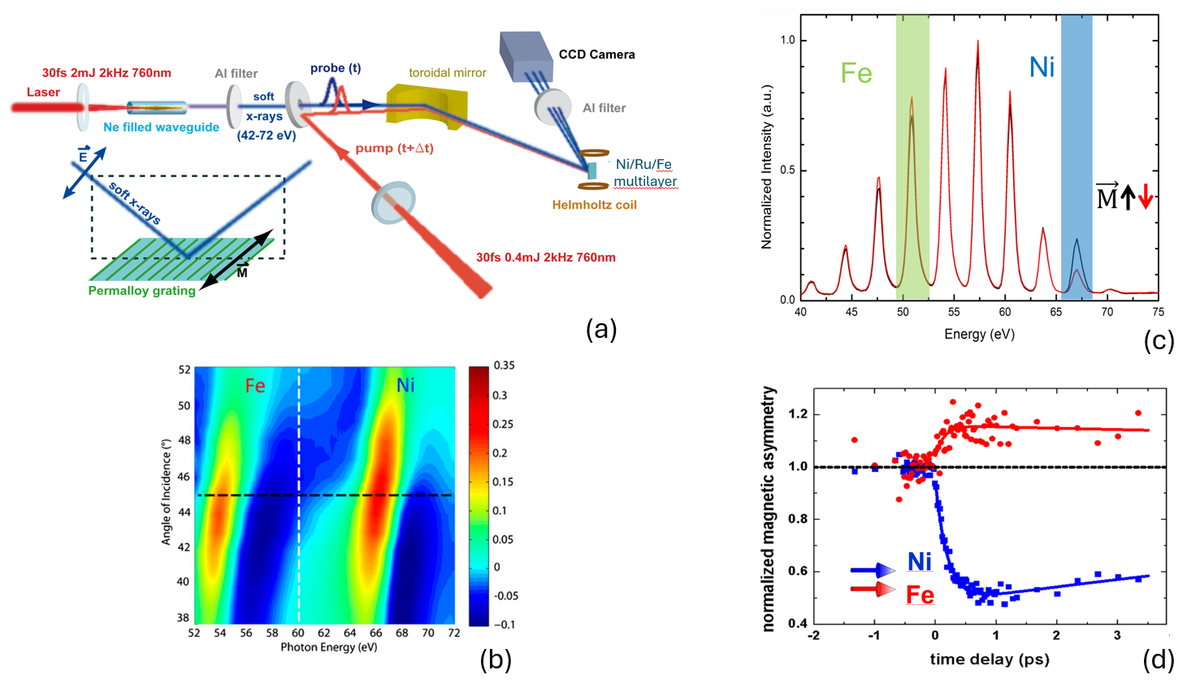High Harmonic Generation (HHG)
An important step towards understanding the spin dynamics in complex magnetic alloys and multilayers requires examining optically induced femtosecond transients with element-selectivity. Such measurements require high-energy photons in the XUV (10 eV - 120 eV) or soft X-ray (100 eV-3 keV) spectral region.

XUV and X-ray photons allow element-selective studies of complex magnetic alloys by using resonant shallow-core-level absorption at the absorption edges characteristic for a chosen element [e. g., 52 eV (Fe), 60 eV (Co), 66 eV (Ni)]. At these absorption photon energies, the magneto-optical Kerr effect (MOKE) is resonantly enhanced due to the spin-orbit and exchange coupling.
High-energy photons can be produced at the large synchrotron facilities around the world. Relatively recently, however, it has been demonstrated that high-energy photons can also be generated by focusing an intense femtosecond laser pulse into a collection of gas atoms, thus generating high-order harmonics of the fundamental laser light that extend into the XUV range. Reflection of the XUV light from a thin multilayer or magnetic alloy film results in an absorption enhancement at the resonant photon energy of the corresponding element.
In our HHG experiments, we combine element-selectivity with femtosecond time resolution to study the magnetic response of NiFe alloys as well as Ni/Ru/Fe multilayers. In the latter experiment, we excited the multilayer with near-infrared laser light and we observed the evolution of magnetization response in the Ni and Fe layers simultaneously but separately using synchronized XUV probe pulses (see the Figure below this section). Following the optical excitation, we detected fluence-dependent magnetization quenching in Ni and magnetization enhancement in the Fe for parallel alignment of Fe and Ni magnetizations. We ascribed the observed response to optically generated superdiffusive spin currents between the layers (see Rudolf et al.).
Time-resolved experiments using laser generated XUV light substantially enhance our knowledge and understanding of ultrafast processes in novel complex materials. They belong to the cutting edge experiments and not only allow a deeper insight into charge and spin dynamics (see further references below), but also have a strong potential for use in charge and spin control on ultrafast time scales for next-generation electronic devices.
Publications
S. Gang, R. Adam, M. Plötzing, M. von Witzleben, C. Weier, U. Parlak, D. E. Bürgler, C. M. Schneider, J. Rusz, P. Maldonado, and P. M. Oppeneer, Element-selective investigation of femtosecond spin dynamics in nipd magnetic alloys using extreme ultraviolet radiation, Phys. Rev. B 97, 064412 (2018)
https://doi.org/10.1103/PhysRevB.97.064412
S. Eich, M. Plötzing, M. Rollinger, S. Emmerich, R. Adam, C. Chen, H. C. Kapteyn, M. M. Murnane, L. Plucinski, D. Steil, B. Stadtmüller, M. Cinchetti, M. Aeschlimann, C. M. Schneider and S. Mathias, Band structure evolution during the ultrafast ferromagnetic-paramagnetic phase transition in Cobalt, Sci. Adv. 3, e1602094 (2017)
https://doi.org/10.1126/sciadv.1602094
M. Plötzing, R. Adam, C. Weier, L. Plucinski, S. Eich, S. Emmerich, M. Rollinger, M. Aeschlimann, S. Mathias, and C. M. Schneider, Spin-resolved photoelectron spectroscopy using femtosecond extreme ultraviolet light pulses from high-order harmonic generation, Review of Scientific Instruments 87, 043903 (2016)
https://doi.org/10.1063/1.4946782
C. Weier, R. Adam, D. Rudolf, R. Frömter, P. Grychtol, G. Winkler, A. Kobs, H. P. Oepen, H. C. Kapteyn, M. M. Murnane, and C. M. Schneider, Femtosecond-laser–induced modifications in Co/Pt multilayers studied with tabletop resonant magnetic scattering, Europhysics Letters 109, 17001 (2015)
https://doi.org/10.1209/0295-5075/109/17001
E. Turgut, C. La-o vorakiat, J. M. Shaw, P. Grychtol, H. T. Nembach, D. Rudolf, R. Adam, M. Aeschlimann, C. M. Schneider, T. J. Silva, M. M. Murnane, H. C. Kapteyn, and S. Mathias, Controlling the competition between optically induced ultrafast spin-flip scattering and spin transport in magnetic multilayers, Phys. Rev. Lett. 110, 197201 (2013)
https://doi.org/10.1103/PhysRevLett.110.197201
D. Rudolf, C. La-O-Vorakiat, M. Battiato, R. Adam, J. M. Shaw, E. Turgut, P. Maldonado, S. Mathias, P. Grychtol, H. T. Nembach, T. J. Silva, M. Aeschlimann, H. C. Kapteyn, M. M. Murnane, C. M. Schneider, and P. M. Oppeneer, Ultrafast magnetization enhancement in metallic multilayers driven by superdiffusive spin current, Nature Communications 3, 1037 (2012)
https://doi.org/10.1038/ncomms2029
